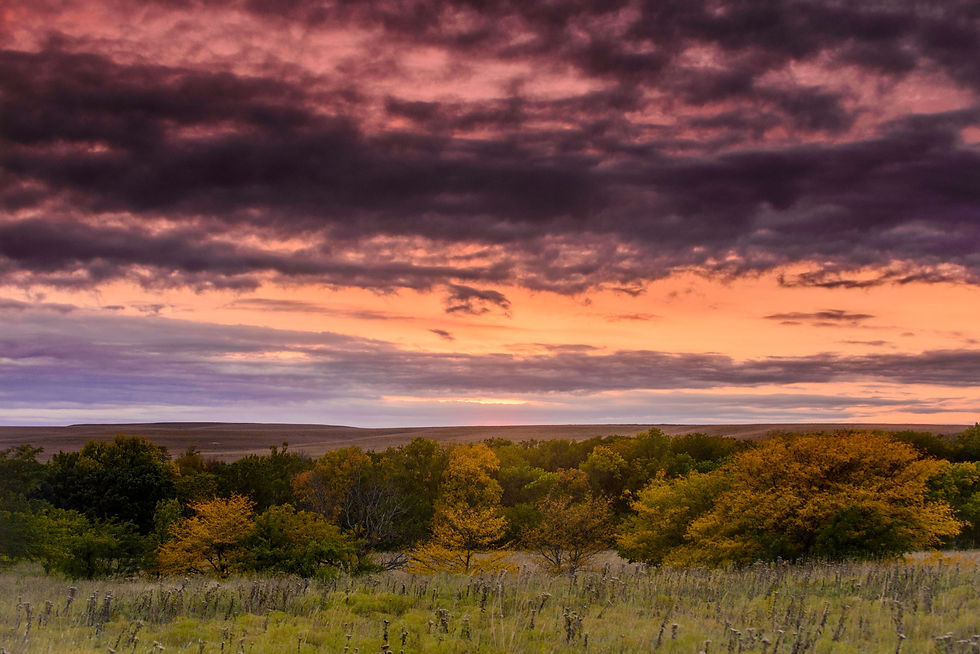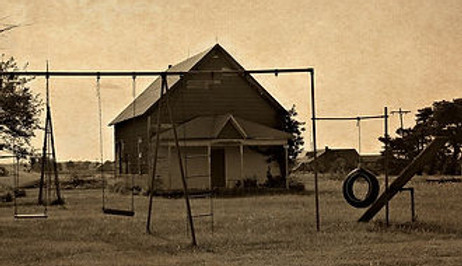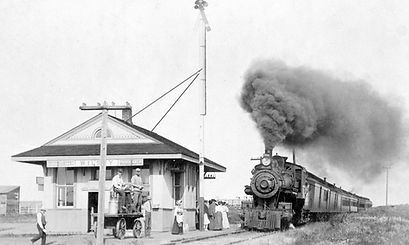

OUR MORRIS COUNTY COMMUNITIES
and Beyond!
Burdick • Council Grove • Delavan • Dunlap • Dwight • Latimer • Parkerville • White City • Wilsey
Morris County, Kansas is so much more than expected. Our charming, rural neighboring towns remind you what small-town living is all about!
They offer extraordinarily fun community festivals, like Dwight Summerfestand so much more! Read on and discover what secrets these charming communities of the Flint Hills hold.
BURDICK
This is a small community of friendly people, located on the edge of the Flint Hills, in southwest Morris County. The town is located two miles south of the Santa Fe Trail’s Six Mile Station, which is identified by a historical marker and where nearby swales are visible. The Burdick Council of Clubs hosts a yearly weekend Burdick Labor Day celebration. At one time, Burdick boasted of two banks, a grocery store and general store, grade and high school (one of the eight high schools in Morris County).

Today, all that remains are the Burdick Meat Locker, family-owned since 1921, and known for its meat processing, beef jerky, and delicious potato sausage – and the Burdick Oil Company, a family-owned, full-service gas station and ranch supply that celebrated its 60th anniversary in 2008.
Burdick High School closed in 1957, sending its students to the new Centre School at Lincolnville – while the Grade School continued into the 60s before sending those students to Centre Grade School.
Many residents in the Burdick community are descendants of Swedes who settled in this area in the 1880s, and the community’s pride in its heritage is shared each Labor Day.
COUNCIL GROVE

Nestled in the Flint Hills alongside the Neosho River, Council Grove received its name on August 10, 1825, when the US Commissioners met with Chiefs of the Great and Little Osage Indian tribes beneath a tree later named the “Council Oak”, to sign the first treaty establishing the right-of-way for the famed Santa Fe Trail. In the years following, Council Grove became the pre-eminent rendezvous point for wagon trains heading west.
It was at Council Grove that small wagon trains and individual travelers gathered to form large wagon trains since Council Grove was the furthest west point to which they could safely travel alone or in small groups. Also, at Council Grove was the last stand of hardwood timber from which wagon repairs could be made.
However, the first permanent settlement in Council Grove did not occur until Seth Hays, great-grandson of the famed Kentucky frontiersman Daniel Boone, established a trading post here in 1847. With the arrival of the railroad, the last Santa Fe wagon train passed through Council Grove in 1866, and the town became a trade center for the local agricultural economy. Today small industries, an active retail community, and tourism form a large part of the local economy.
A town of a little over 2,100 residents, Council Grove proudly boasts its many historic sites, more than 24 of which have attained national recognition. The nearby Council Grove City Lake and Council Grove Federal Reservoir attract fishermen, boaters, and campers from everywhere. The Kaw Mission State Historic Site in Council Grove and the Kaw Nation’s Allegawaho Memorial Heritage Park (about 3.5 miles southeast of Council Grove), is dedicated to telling the story of the Kaw (or Kansa) Indian Tribe, whose reservation was located here from 1847 to 1873.
DELEVAN

Delavan was founded in 1885 by Henry Kingman, who named the community after his hometown of Delavan, Illinois. By 1886, the Topeka, Salina, and Western Railway extended from Council Grove to a point just east of Delavan, where it languished four years until Jay Gould’s Missouri-Pacific Railroad took over and completed the rail line onto Colorado. Like other small Morris County towns, Delavan thrived in the first half of the 20th century, having a grade and high school, a general store (food and merchandise), a lumber yard, a farm
machinery dealership, a bank, and a telephone office. Like the other small Morris County communities, the Delavan Bank failed during the Great Depression of the early ‘30s. The Delavan High School closed in 1950, with students bussing into Wilsey for classes. All that remains of Delavan today is the Grandview Township Community Center converted from the original Delavan Grade School. This community was very busy during World War II as the Herington Army Airfield, a major bomber and, eventually, a B-29 base, was constructed just north of the city’s boundaries.

DUNLAP
The City of Dunlap was founded in 1869 by Joseph Dunlap and incorporated in 1875. During the Great Exodus after Reconstruction following the Civil War, 40,000 black settlers came to Kansas. Benjamin “Pap” Singleton, a former slave himself, and Columbus Johnson brought 200 black settlers to the Dunlap area in May 1878 to purchase their own farmlands and begin their new lives as freed people. In just two years, the number of settlers coming to Dunlap exploded.

During its heyday, Dunlap boasted a blacksmith shop, hardware store, grocery store, ice cream parlor, flour mill, butter and cheese factory, restaurant, and four banks. By the mid-1900s, Dunlap High School boasted the “best gymnasium in the county” and hosted the Morris County High School Basketball Tournament for many years. Like many other businesses, most of its banks closed during the Great Depression. The Guaranty State Bank remained open until 1961. Most of the buildings along the main street of town have been demolished. The post office closed in the 1980s, and the last formal church denomination merged with a nearby town's congregation and closed its doors in 2012.
DWIGHT
When the Chicago, Kansas, and the Nebraska Railway Co. decided to extend the Rock Island System west from Topeka in 1887, developers purchased land and platted the town of Dwight. The town was named after Dwight Rathbone, who donated land for the Dwight Methodist Episcopal Church. The Presbyterian and Methodist churches have been most important in the life of this community.

While visiting Dwight, one can find the Swartz School Museum located on Main Street. It was the first school to be established in the Ohio Township around 1871. The Swartz School was originally located about two and one half miles southeast of Dwight and was the first place of many public meetings.
LATIMER

Like other banks in the county, the Latimer State Bank closed during the Great Depression. The Zion Lutheran Church closed in December 2021, but there is a group working to restore and preserve it for its historical significance. Click here to find out how you can help!
PARKERVILLE
Charles G. Parker, former Santa Fe Trail wagon train freighter, founded the town of Parkerville alongside the Missouri, Kansas, and Texas Railway (the KATY Railroad) in 1870. In 1871, it became only the second incorporated town in Morris County and immediately challenged Council Grove for the County Seat – losing 413 – 899 to Council Grove in the ensuing election. Like the other small farming communities of Morris County, Parkerville thrived through the late 1870s into the mid-20th century with a grade and high school, bank, newspaper, law offices, a veterinarian, grocery store, and other businesses. Parkerville High School – one of eight high schools in the county – closed in 1945, with most students going into White City High School. The Parkerville Grade School, however, held classes until 1966. The bank closed during the Great Depression in 1931. In the early 20th century, a horse race track thrived, drawing spectators from a large area. All that remains today is the Parkerville Baptist Church, a very active religious facility, in this once, proud, active community.


WHITE CITY

Established in 1870 as a part of the Missouri-Kansas-Texas (KATY) Railroad, the town was developed by two men who purchased 80 acres of ground on either side of the “KATY” tracks. They recruited settlers and immigrants from the northeastern part of the country. Known as Morris County’s “little city on the hill,” it sits on one of the highest elevations in the Flint Hills. Be sure to visit the historic two-story Stone Store, now a bed-and-breakfast, the one-room Baxter School House, and the KATY Railroad Rail Car Museum.
It is ideal for the avid hunter and fisherman, and is a great place to raise a family! White City offers its residents the friendliness of small-town living, including an outstanding Pre-K to 12th-grade school system, many area churches, friendly small-town merchants, a convenient local grocery store, public library, hometown newspaper, and Katy Park and Baxter School House museum.
WILSEY
The community of Wilsey started around 1884 as a major water stop for the steam trains of that era. Later, the town became a major mail stop for the railroad. The town thrived during that time with many stores and businesses into the 1950s and ‘60s, with two grocery stores, two restaurants, a drug store, a lumber yard, and a hardware store that was the envy of many other Morris County communities.

At one time, there were two filling and service stations and a mechanic shop doing auto and tractor repairs. Of course, there was the inevitable grain elevator. The weekly newspaper, the Wilsey Warbler, ceased publication in the late ‘30s, and the Wilsey Bank went broke during the depression of the early ‘30s. The Wilsey High School merged into USD 417, and students began attending Council Grove High School in the late 1960s. The Wilsey Grade School closed, and students moved to Council Grove in the 1990s. The former high school complex now houses the Wilsey Bible School. Although the town is much smaller today, Wilsey has a proud history and welcomes visitors.
